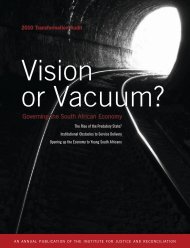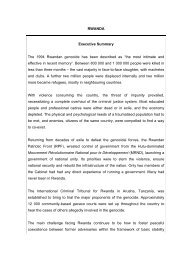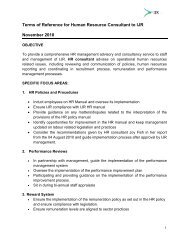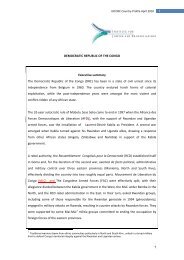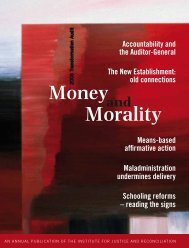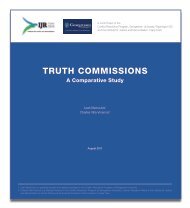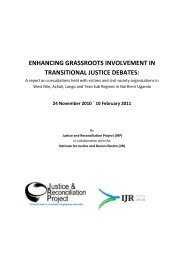CHAPTER 3 Education and skills - Institute for Justice and ...
CHAPTER 3 Education and skills - Institute for Justice and ...
CHAPTER 3 Education and skills - Institute for Justice and ...
Create successful ePaper yourself
Turn your PDF publications into a flip-book with our unique Google optimized e-Paper software.
eviewFROM JIPSA TO HRD-SA: CONTINTUITY ANDDISJUNCTURE IN THE DEVELOPMENT OF ANATIONAL HUMAN RESOURCE STRATEGYRenee GrawitzkyWith much talk about a crisis in education <strong>and</strong> <strong>skills</strong>, thelong awaited Human Resource Development Strategy <strong>for</strong>South Africa: 2010–2030 (HRD-SA) was expected to bringgreater co-ordination, cohesion <strong>and</strong> focus to developing thecountry’s human capital. A change in the configuration ofgovernment structures, coupled with the need of the newadministration to meet its electoral m<strong>and</strong>ate, has resulted inthe strategy being sent back to the drawing board. In view ofthis decision, this paper examines the key elements of theproposed strategy, the extent to which it built on the JointInitiative on Priority Skills Acquisition (JIPSA) experience<strong>and</strong> the potential challenges that now exist.In 2005, the Department of <strong>Education</strong> (DoE) wasm<strong>and</strong>ated by the government to revise the country’s firstpost-apartheid human resource development (HRD) strategy,which was released in 2001 under the title Human resourcedevelopment strategy <strong>for</strong> South Africa: A nation at work <strong>for</strong> abetter life. Within months of this initiative, the governmentlaunched the Accelerated <strong>and</strong> Shared Growth Initiative <strong>for</strong>South Africa (ASGISA), which singled out <strong>skills</strong> shortages asone of the most stubborn obstacles to growth <strong>and</strong>diversification of the economy. This realisation led to thelaunch of JIPSA in 2006 by the then Deputy PresidentPhumzile Mlambo Ngcuka. A non-statutory <strong>for</strong>um, JIPSAwas viewed as a short-term intervention aimed at addressingthe immediate <strong>skills</strong> shortages facing the country.Some have argued that the development of JIPSA was aresponse to the lack of co-ordination within <strong>and</strong> aroundHRD in the government. As the JIPSA process unfolded, thegovernment threw its weight behind it <strong>and</strong>, as a result, the2001 HRD strategy, due to a lack of prioritisation, failed togain momentum. The political imperative to ensure thesuccess of ASGISA was immediately urgent, while the HRDstrategy, on the other h<strong>and</strong>, was viewed as a long-termgovernment policy that was not a pressing priority. A strategydocument was finally completed <strong>and</strong> published <strong>for</strong> publiccomment in December 2008.In response to the 2005 m<strong>and</strong>ate, the DoE finally presenteda revised HRD strategy document (underpinned by extensiveconsultation <strong>and</strong> a process of public comment) to the Cabinetin March 2009. The preamble to the 2009 version of theHRD-SA states that extensive input was received from socialpartners, which is ‘vital to the success of this strategy <strong>and</strong> isessential <strong>for</strong> the strategy to be credible’.The Cabinet’s endorsement of the strategy paved the way<strong>for</strong> the integration of the JIPSA secretariat into the HumanResource Development Support Unit (located in the DoE),which is supposed to provide the administrative support <strong>for</strong>the implementation of the strategy <strong>and</strong>, in particular, <strong>for</strong> theproposed Human Resource Development Council (HRDC),which is tasked with driving the implementation of thestrategy.With a new political guard in government <strong>and</strong> the changesannounced in the aftermath of the appointment of the newCabinet, the strategy document was referred back to theCabinet in August 2009. According to Firoz Patel, DeputyDirector-General: System Planning <strong>and</strong> Monitoring in theDepartment <strong>for</strong> Higher <strong>Education</strong> <strong>and</strong> Training (DHET), thedecision to refer the document back to the Cabinet was basedon a view that there was a need to update the strategy totake into account the m<strong>and</strong>ate of the new administration<strong>and</strong>, most importantly, because of the restructuring of thegovernment (interview, October 2009). The notable changesincluded the shifting of responsibility <strong>for</strong> <strong>skills</strong> developmentfrom the Department of Labour (DoL) to the newly establishedDHET. In addition, further education <strong>and</strong> training (FET)colleges moved from the DoE to DHET, ensuring that <strong>skills</strong>development <strong>and</strong> FET colleges fell under the administrationof the same department.A central tenet of the training re<strong>for</strong>m strategy, the NationalTraining Strategy Initiative, which was drafted during thetransition period <strong>and</strong> which influenced post-1994 legislation,was that some <strong>for</strong>m of integration should exist betweeneducation <strong>and</strong> training. A key assumption was that education<strong>and</strong> training would fall under the same governmentdepartment so as to ensure a unified approach. In the post-1994 period, this did not materialise, <strong>and</strong> the lack ofalignment <strong>and</strong> synergy between the two departments mighthave negatively contributed to problems that emergedaround the delivery of <strong>skills</strong>.In the new Zuma government, other changes with thepotential to impact on the HRD strategy were the establishmentof the Department <strong>for</strong> Economic Development <strong>and</strong> thetwo ministries in the Presidency relating to planning, <strong>and</strong>monitoring <strong>and</strong> evaluation.It is understood that during Cabinet discussions in August2009, the predominant view was that the HRD-SA needed84 RECESSION AND RECOVERY2009 Trans<strong>for</strong>mation Audit



